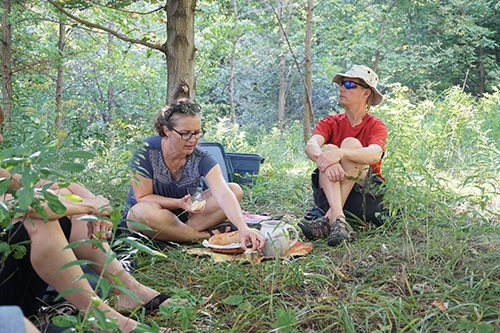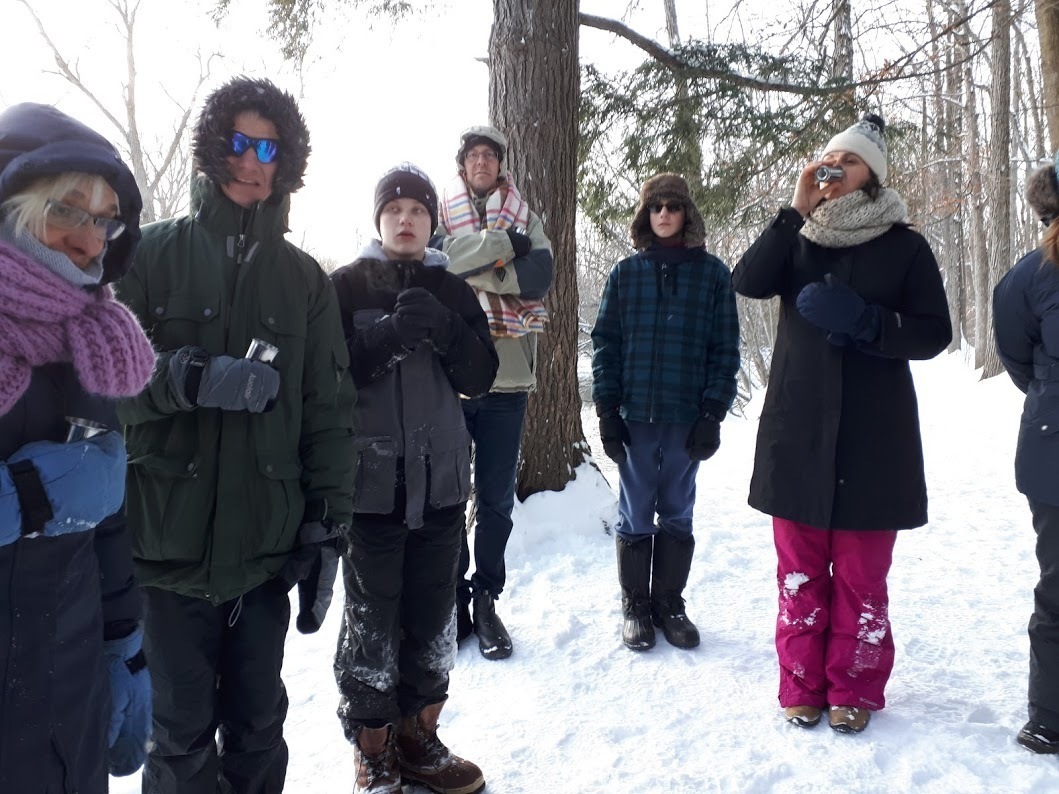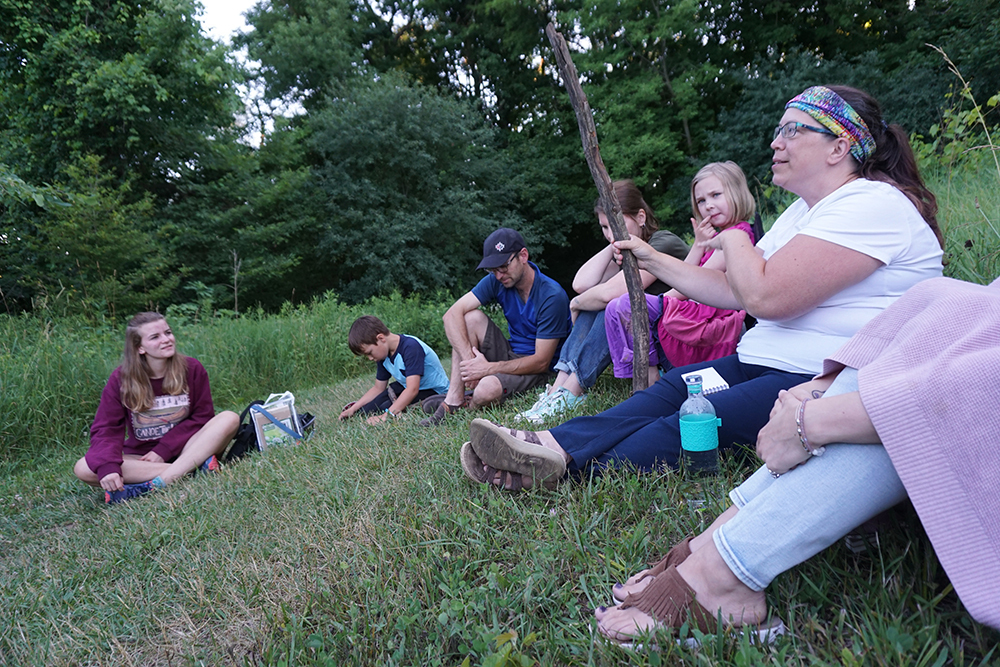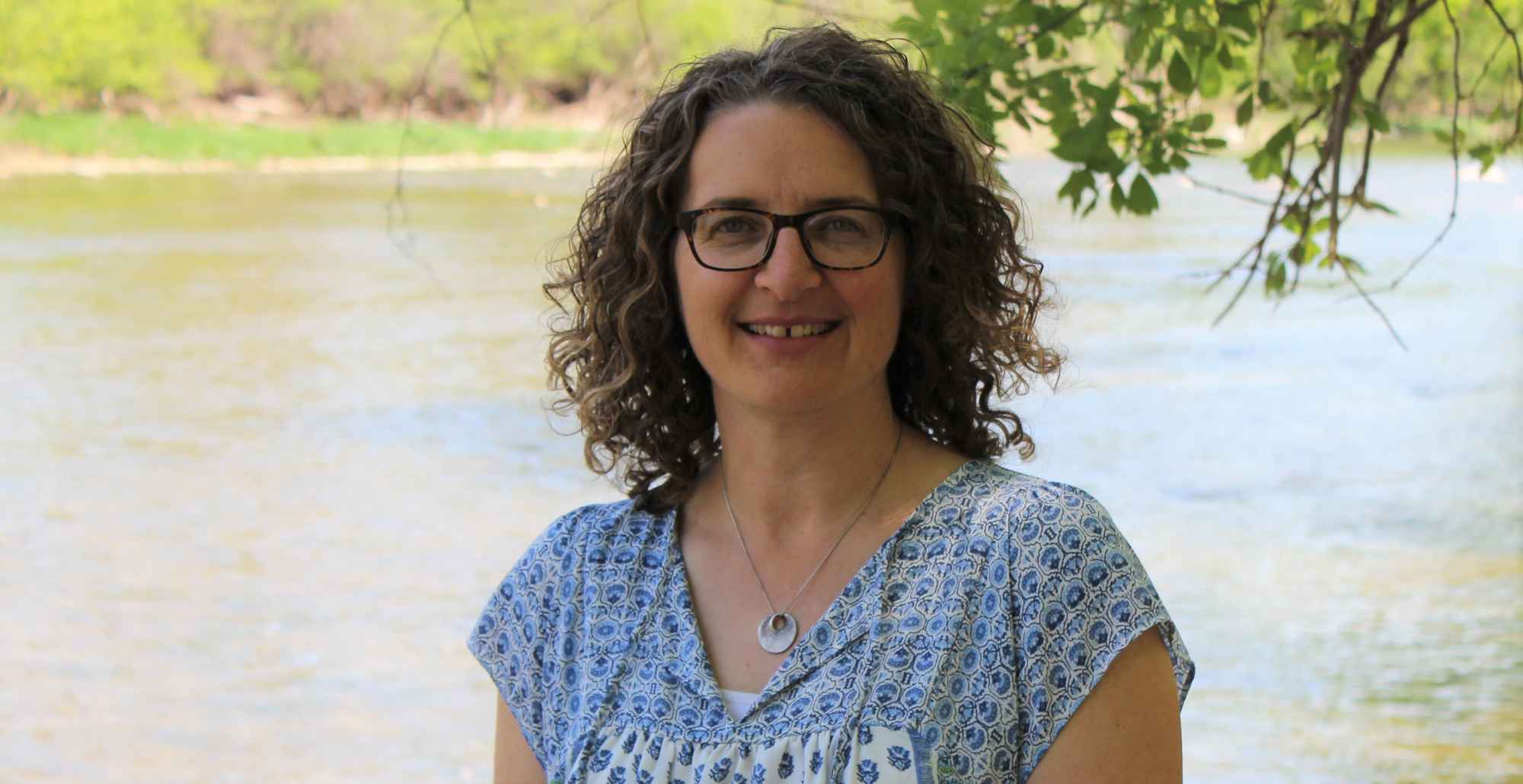August 5th, 2020What would happen if my congregation was the natural world?
An interview with pastor Wendy Janzen from Burning Bush Forest Church on worshipping with nature and how outdoor church challenges our need for control
Wendy Janzen is the pastor of Burning Bush Forest Church in Kitchener, Ont., a wild church that meets monthly in the outdoors in urban parks and forests.
Janzen is also pastor of St. Jacobs Mennonite Church. She pastored for 21 years before forming Burning Bush in the spring of 2016. She is a founding partner of the Wild Church Network, an organization that resources wild churches across North America.
As a teenager, Janzen moved from Saskatoon to a farm one kilometre west of Rosthern, Sask. On the farm she became “in tune with the rhythm of the seasons.” At Camp Shekinah, a nearby Mennonite Bible camp, Janzen became close to the land by swimming in the creek and hiking the hills.
On August 4 and August 6, Janzen is speaking in webinars hosted by Wild Church Network and Mennonite Creation Care Network respectively. She will answer questions and offer advice on incorporating outdoor worship into Sunday morning services, which has become more appealing to churches due to COVID-19.
In an interview with Katie Doke Sawatzky, Janzen shares about Burning Bush and why people find worshipping in nature more engaging than sitting in the pews.




Caption: Wendy Janzen prepares communion in the first picture and is pictured above. Photo source: Wendy Janzen.
KDS: Tell me a bit about growing up on the prairies.
WJ: The North Saskatchewan River Valley at Camp Shekinah and the wide open prairies on the farm shaped my experience of the world and of life. I attended church but felt God more personally when I was at camp or when I was staring up at the clouds or at the spectacular sunsets, or watching my parents watch the storms as they'd roll in. They worried about whether the hail would take the year's crop and I realized we are not as in control as we think we are. You need faith and trust when you farm.
KDS: How were you led to form Burning Bush Forest Church?
WJ: During a sabbatical in 2014, I visited emerging churches that were doing things differently. I didn't have any sense I wanted to start something new but God has plans for us that we don't always recognize at first. That fall my neighbour told me she was done with traditional church. She didn't feel connected to God there and said she'd rather be out on a hike on a Sunday morning with her family. I sensed there were a lot of people who felt that way and that we needed to pay attention to them rather than being defensive and saying, “Well, if you just put more into it you'd get more out of it.”
That same fall my oldest son was enrolled in a pilot project for a one-day-a-week forest school. I went to pick him up one afternoon and had an epiphany. Maybe there could be forest church, where we immerse ourselves in nature and allow God's spirit to work with us there.
I googled it and found a network in the UK called the forest church. I became more and more excited. In December I phoned my neighbour, said I wanted to do forest church the next day and asked her to join me. She said yes absolutely and invited other people. With less than 24 hours’ notice, 15 of us gathered for worship on the last Sunday of December and that was my first experience of forest church. It took about a year before I got organized enough to start a regular monthly worship gathering. That started in March of 2016.
KDS: Can you describe what the gathering is like, at Burning Bush?
WJ: We stand together in a circle. I do an opening grounding prayer, which draws our bodies and spirits into awareness of the place where we're gathered. We greet the sky, the trees and the creatures. We use our senses to be aware of the temperature on our skin, the smells on the air or the firmness of the Earth beneath our feet and God's presence in all of that. Then we have Scripture and poetry readings and a brief message—nowhere near the length of a sermon. Then people go and spend half an hour wandering. They might spend time reflecting on the readings or maybe the water in the creek catches their attention. We come back together, share our experiences and have a closing benediction.
I've often told people there's a three-part sermon: the first part is the way Scripture speaks to us, the second part is listening to God in our natural setting and the third part is when we share with each other.
KDS: Who are the folks that come?
WJ: It's a mix of people who attend other churches and find Burning Bush to be an important supplement and people who don't attend other churches. The latter are mostly people who attended church growing up but no longer do. There are families and then up to early retirement age. There's always visitors who have found out about it somehow and come to check it out. It's not one consistent, tight-knit community; it's a flowing attendance.
KDS: Do you have a sense of why people come?
WJ: People are longing for ways to connect with creation. Some people enjoy more contemplative worship so that might be what draws them. I think a lot of people would say that nature has always been a place where they've sensed God's presence, so it’s a natural fit for them to come to a worship service that's outside.
There's a broad range of expression in terms of how people are called to engage their faith and their relationship with God. Inviting people to do this in nature opens up an option for people who don’t find that in traditional church.
KDS: What are the challenges of forming an outdoor church?
WJ: Finding an appropriate space that is accessible and that you can direct people to. I try to find places that have natural space with water, like a pond or creek, so not manicured parks but more forested areas that are accessible by public transportation, cycling or cars. We haven't found any places that have shelter or bathrooms, so that's a limitation. We have had a person in a wheelchair come and it's workable but it's always helpful to know ahead of time.
Trying to communicate with people is a challenge because we're reliant on an e-mail list, our website and Facebook page. It's a little harder than when you're all at a church together and you can make your announcements and know that everyone hears the information.
You never know what the weather’s going to be like. We try to meet no matter the weather unless it poses a safety concern. If it's just rainy or cold, we still go out. If you can take your dog out for a walk or go cross-country skiing or skating in winter, then you can also go outside and worship. We don't sit down, we keep moving so that helps.
KDS: Has encountering those challenges given you insight into what worshiping communities can be like?
WJ: I learned a lesson in my first year of forest church. It was a beautiful September afternoon and for whatever reason no one came except for me. I went ahead with the service anyway. We talk about worshiping in nature as a location but what about with nature? Scripture talks about the heavens declaring the glory of God, the trees clapping their hands in praise. So what would happen if my congregation was the natural world? That was a great learning experience for me to feel that tangibly, rather than just think that nature is capable of worshipping God.
Being outside for a sunrise service, even though it's cold in April, is much more invigorating than an indoor sunrise service. Our worship takes on a different feeling when we're huddled under blankets, holding hot drinks, waiting for the sun to rise. The sun peeks between the branches of the trees, the birdsong is our praise music. It's not polished. It's not well-perfected and controlled because you don't know if you're actually going to see the sunrise—maybe it'll be cloudy. It's spontaneous and go-with-the-flow.
KDS: Is not being in control something that people need to experience more often?
WJ: I think so. In North America, many of us have gotten to a place in life where we feel like we're in control of everything and so we don't really need God. We like to plan every little piece of our lives so we know what to expect. It's good to be able to let go of that and realize God is ultimately in control.
KDS: The description of the Wild Church Network webinar you are part of this Thursday, August 6, mentions that churches are feeling the “COVID call to experiment with outdoor worship." Can you expand on that?
WJ: Perhaps more in the U.S. right now than in Canada there are churches looking for safer ways to meet for worship. They won’t necessarily become a wild church or a regular outdoor church but they have practical questions about moving their congregation outdoors. We as a network can share our experiences and brainstorm ways they can listen to God speak through natural settings. We're inviting churches who may have not have ever considered what it means to worship outside to experience that.
KDS: How has COVID-19 affected Burning Bush and your work?
WJ: We stopped meeting in mid-March. I asked my advisory team if we should we meet on Zoom or pre-record services for YouTube. Everyone's sense was that life had gone too quickly online and there was no appetite for adding a virtual form of forest church to that. It felt too antithetical to the experience so we chose not to do virtual worship together. I created self-led spiritual practices in nature that people could do each month that were circulated in our newsletter. We gather in person again in August.
KDS: What's your hope in this work?
WJ: That the landscape of the church continues to grow and expand beyond our traditional understandings of what church and worship should look like. There's a broad range of expression in terms of how people are called to engage their faith and their relationship with God. Inviting people to do this in nature opens up an option for people who don’t find that in traditional church.
Secondly, I hope that we deepen our relationship with the Earth. Resurrection and renewal take on deeper meaning when you watch the life cycles around us. Every fall there's death and new life again in the spring. I hope forest church helps bring us back to a reciprocal relationship with the Earth, recognizing its sacredness, that God is present there and that we're all bound up together in a community of creation.
KDS: It's easy to look at the statistics of how much time we have left before global warming becomes unstoppable and not have hope. How do you respond that?
WJ: Certainly we are in deep trouble but being paralyzed by that and throwing our hands up in the air does not help. Living in hope means modelling our lives in such a way that we believe we can make a difference, that the Earth can restore itself if we give it a chance. We need to let go of the way things have been and trust God will walk with us into the uncertainty of the future. I have to trust and hope that there is a way forward.